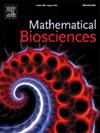Advection-dominated models of atherosclerotic plaque composition: The impacts of cell death and cholesterol toxicity
IF 1.8
4区 数学
Q2 BIOLOGY
引用次数: 0
Abstract
Advanced atherosclerotic plaques are characterised by a large necrotic core containing highly inflammatory lipids and debris from dead cells. In large plaques, newly recruited macrophages fail to penetrate this core, and instead push existing material deeper inside the plaque. In this paper, we consider two multiphase models for early atherosclerotic plaque growth, and we analyse their behaviour in the limiting regime where bulk advection drives mass transport of cells and lipids. In this regime, the dynamics of the deep plaque can be approximated by a system of advection–reaction equations. By applying the method of characteristics to these equations, we derive a set of ODEs that describes the evolution of individual segments of plaque tissue. We apply this approximation to a simple 1D three-phase model comprising macrophage foam cells, dead cells, and modified LDL, and we investigate how plaque tissue composition depends on the relative rates of cell death and efferocytosis (cell recycling). We also consider a six-phase model in which death rates depend on intracellular cholesterol content. We use this model to study the effects of cholesterol-induced toxicity, and the beneficial effects of high density lipoproteins (HDL), which can remove excess cholesterol from macrophages. We show that for both multiphase models, the advection–reaction approximations capture key structural features of the full model solutions, including the relative proportions of live and dead cells, and persistent spatial heterogeneities that arise from time-varying boundary influxes of LDL and HDL.
动脉粥样硬化斑块组成的平流主导模型:细胞死亡和胆固醇毒性的影响。
晚期动脉粥样硬化斑块的特征是含有高度炎症性脂质和死细胞碎片的大坏死核心。在大的斑块中,新招募的巨噬细胞不能穿透这个核心,而是将现有的物质推入斑块的更深处。在本文中,我们考虑了早期动脉粥样硬化斑块生长的两种多相模型,并分析了它们在大量平流驱动细胞和脂质大量运输的限制状态下的行为。在这种情况下,深斑块的动力学可以用平流-反应方程系统来近似。通过将特征方法应用于这些方程,我们推导出一组描述斑块组织单个片段演化的ode。我们将这一近似应用于一个由巨噬细胞泡沫细胞、死细胞和修饰LDL组成的简单1D三相模型,并研究斑块组织组成如何依赖于细胞死亡和efferocytosis(细胞再循环)的相对速率。我们还考虑了一个六阶段模型,其中死亡率取决于细胞内胆固醇含量。我们使用这个模型来研究胆固醇诱导的毒性作用,以及高密度脂蛋白(HDL)的有益作用,高密度脂蛋白可以从巨噬细胞中去除多余的胆固醇。研究表明,对于两种多相模型,平流反应近似捕捉了完整模型溶液的关键结构特征,包括活细胞和死细胞的相对比例,以及由LDL和HDL随时间变化的边界流入引起的持续空间异质性。
本文章由计算机程序翻译,如有差异,请以英文原文为准。
求助全文
约1分钟内获得全文
求助全文
来源期刊

Mathematical Biosciences
生物-生物学
CiteScore
7.50
自引率
2.30%
发文量
67
审稿时长
18 days
期刊介绍:
Mathematical Biosciences publishes work providing new concepts or new understanding of biological systems using mathematical models, or methodological articles likely to find application to multiple biological systems. Papers are expected to present a major research finding of broad significance for the biological sciences, or mathematical biology. Mathematical Biosciences welcomes original research articles, letters, reviews and perspectives.
 求助内容:
求助内容: 应助结果提醒方式:
应助结果提醒方式:


